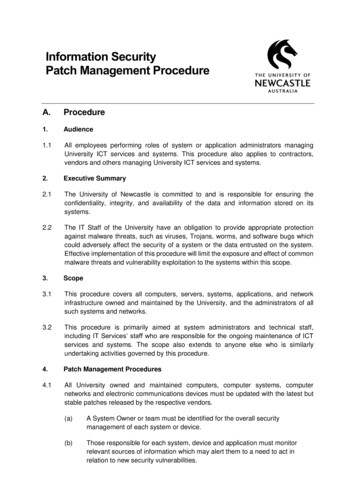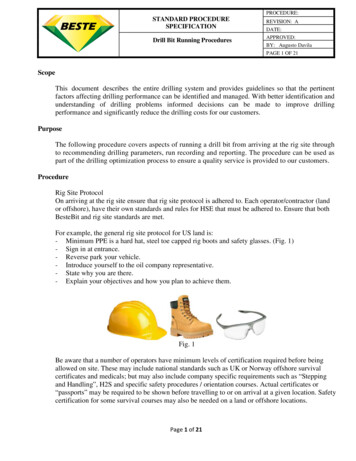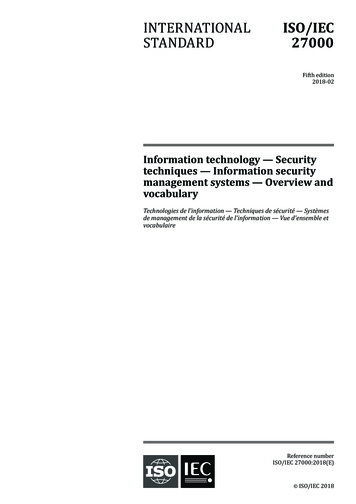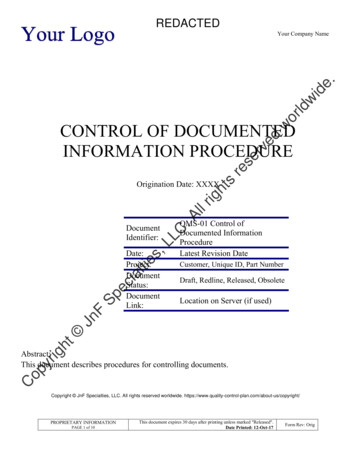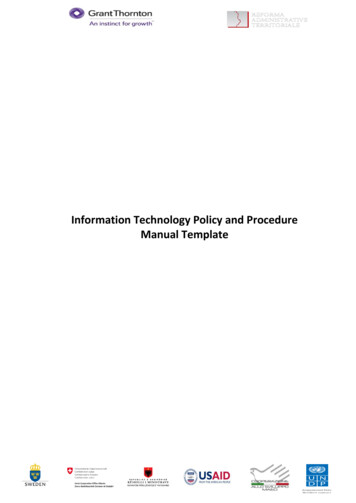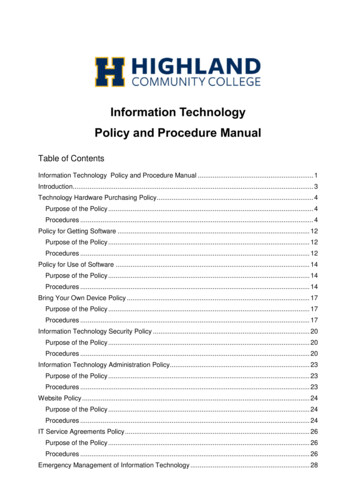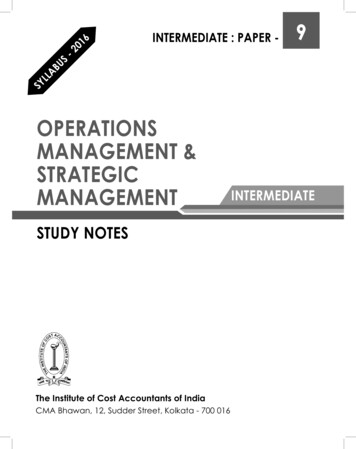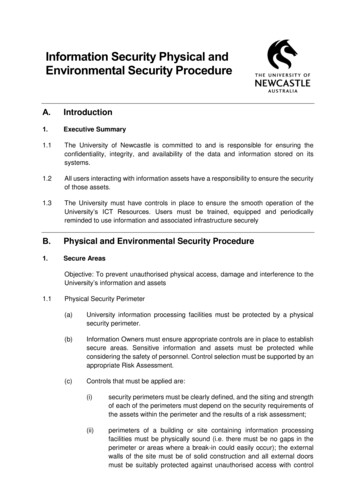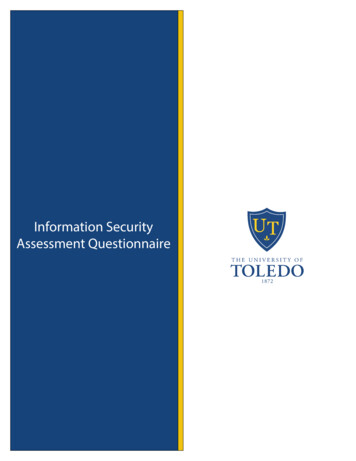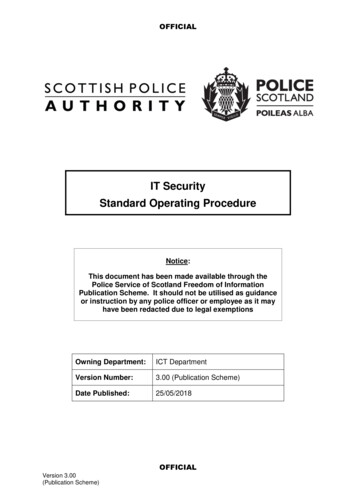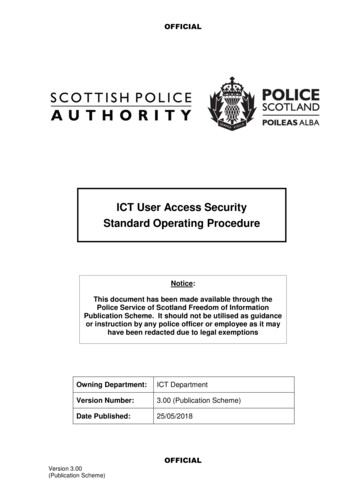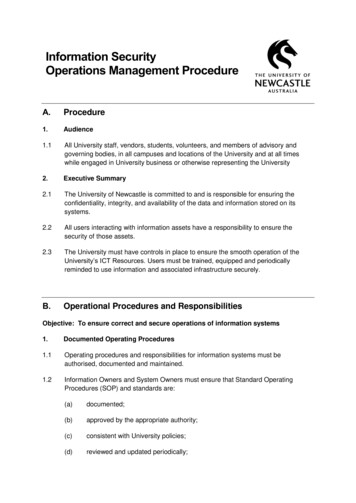
Transcription
Information SecurityOperations Management ProcedureA.Procedure1.Audience1.1All University staff, vendors, students, volunteers, and members of advisory andgoverning bodies, in all campuses and locations of the University and at all timeswhile engaged in University business or otherwise representing the University2.Executive Summary2.1The University of Newcastle is committed to and is responsible for ensuring theconfidentiality, integrity, and availability of the data and information stored on itssystems.2.2All users interacting with information assets have a responsibility to ensure thesecurity of those assets.2.3The University must have controls in place to ensure the smooth operation of theUniversity’s ICT Resources. Users must be trained, equipped and periodicallyreminded to use information and associated infrastructure securely.B.Operational Procedures and ResponsibilitiesObjective: To ensure correct and secure operations of information systems1.Documented Operating Procedures1.1Operating procedures and responsibilities for information systems must beauthorised, documented and maintained.1.2Information Owners and System Owners must ensure that Standard OperatingProcedures (SOP) and standards are:(a)documented;(b)approved by the appropriate authority;(c)consistent with University policies;(d)reviewed and updated periodically;
1.3(e)reviewed and updated when there are changes to equipment/systems orchanges in business services and the supporting information systemsoperations; and(f)reviewed and updated following a related security incident investigation.The documentation must contain detailed instructions regarding:(a)information processing and handling;(b)system restart and recovery procedures;(c)backup and recovery including on-site and off-site storage;(d)exceptions handling, including a log of exceptions;(e)output and media handling, including secure disposal or destruction;(f)Management of audit and system log h)computer room management and safety;(i)Information Incident Management Process;(j)Disaster Recovery;(k)Business Continuity Plan; and(l)contact information for operations, technical, emergency and 2.Change Management2.1Changes to business processes and information systems that affect informationsecurity must be controlled.2.2All changes to the University’s ICT services and systems environment, includingprovisioning and de-provisioning of assets, promotion of code, configuration changesand changes to Standard Operating Procedures must be authorised by the UniversityIT Change Advisory Board (CAB).2.3The change management process must follow the guidelines, approvals andtemplates provided as per the University Transition Process.2.4Changes must be controlled by:(a)identifying and recording significant changes;(b)assessing the potential impact, including that on security, of the changes;
2.52.6(c)obtaining approval of changes from those responsible for the informationsystem;(d)planning and testing changes including the documentation of rollbackprocedures;(e)communicating change details to relevant personnel, Users and stakeholders;and(f)evaluating that planned changes were implemented as intended.Information Owners and System Owners must plan for changes by:(a)assessing the potential impact of the proposed change on security byconducting a security review and a Threat and Risk Assessment;(b)identifying the impact on agreements with business partners and externalparties including information sharing agreements, licensing and provision ofservices;(c)preparing change implementation plans that include testing and contingencyplans in the event of problems;(d)obtaining approvals from affected Information Owners; and(e)training technical of operational staff as necessary;Information Owners and System Owners must implement changes by:(a)notifying affected internal parties, business partners and external parties;(b)following the documented implementation plans;(c)training users if necessary;(d)documenting the process throughout the testing and implementation phases;and(e)confirming the changes have been performed and no unintended changes tookplace3.Capacity Management3.1The use of information system resources must be monitored and optimised withprojections made of future capacity requirements.3.2Information Owners and System Owners are responsible for implementing capacitymanagement processes by:(a)documenting capacity requirements and capacity planning processes;(b)including capacity requirements in service agreements; and
(c)3.3monitoring and optimising information systems to detect impending capacitylimit.Information Owners and System Owners must project future capacity requirementsbased on:(a)new business and information systems requirements;(b)statistical or historical capacity requirements; and(c)current and expected trends in information processing capabilities (e.g.introduction of more efficient hardware or software).3.4Information Owners and System Owners must use trend information from thecapacity management process to identify and remediate potential bottlenecks thatpresent a threat to system security or services4.Separation of Development, Testing and Production Environments4.1Development, testing and production environments must be separated to reduce therisks of unauthorised access or changes to the production environment.4.2Information Owners and System Owners must:(a)separate production environments from test and development environments byusing different servers, networks and where possible different domains;(b)ensure that production servers do not host test or development services orapplications;(c)prevent the use of test and development identities as credentials for productionsystems;(d)store source code in a secure location away from the production environmentand restrict access to specified personnel;(e)prevent access to compilers, editors and other tools from production systems;(f)use approved change management processes for promoting software fromdevelopment/test to production;(g)prohibit the use of production data in development, test or training systems;and(h)prohibit the use of sensitive information in development, test or training systemsin accordance with the System Acquisition, Development and MaintenanceProcedure
C.Protection from MalwareObjective: To ensure that information systems are protected against malware1.Controls Against Malicious Code1.1Detection, prevention and recovery controls – supported by user awarenessprocedures – must be implemented to protect against malware.1.2Information Owners and System Owners must protect University information systemsfrom malicious code by:(a)installing, updating and using software designed to scan, detect, isolate anddelete malicious code;(b)preventing unauthorised Users from disabling installed security controls;(c)prohibiting the use of unauthorised software;(d)checking files, email attachments and file downloads for malicious code beforeuse;(e)maintaining business continuity plans to recover from malicious code incidents;(f)maintain a critical incident management plan to identify and respond tomalicious code incidents;(g)maintaining a register of specific malicious code countermeasures (e.g.blocked websites, blocked file extensions, blocked network ports) including adescription, rationale, approval authority and the date applied; and(h)developing user awareness programs for malicious code countermeasures.1.3University IT Security staff are responsible for communicating technical advice andproviding information and awareness activities regarding malicious codeD.BackupObjective: To protect against loss of data1.Information Backup1.1Backup copies of information, software and system images must be made, secured,and be available for recovery.1.2Information Owners and System Owners must define and document backup andrecovery processes that consider the confidentiality, integrity and availabilityrequirements of information and information systems.1.3Backup and recovery processes must comply with:(a)University business continuity plans (if applicable);
1.41.5E.(b)policy, legislative, regulatory and other obligations; and(c)records management requirements (refer Records Management Policy).The documentation for backup and recovery must include:(a)types of information to be backed up;(b)schedules for the backup of information and information systems;(c)backup media management;(d)methods for performing, validating and labelling backups; and(e)methods for validating the recovery of information and information systems.Backup media and facilities must be appropriately secure based on a security reviewor Risk Assessment. Controls to be applied include:(a)use approved encryption;(b)physical security;(c)access controls;(d)methods of transit to and from off-site locations;(e)appropriate environmental conditions while in storage; and(f)off-site locations must be at a sufficient distance to escape damage from anevent at the main sitePrinciplesLog ManagementObjective: To log events and monitor compliance1.Event Logging1.1Event logs recording user activities, exceptions, faults and information security eventsmust be produced, kept and regularly reviewed.1.2Information Owners must ensure that event logs are used to record user and systemactivities, exceptions and events (security and operational). The degree of detail to belogged must be based on the value and sensitivity of the information and the criticalityof the system. The resources required to analyse the logs must also be considered.Where applicable, event logs must include:(a)user ID;(b)system activities;(c)dates, times and details of key events (e.g. logon, logoff);
(d)device identity and location;(e)logon method;(f)records of successful and unsuccessful system access attempts;(g)records of successful and unsuccessful data and other resource accessattempts;(h)changes to system configuration;(i)use of elevated privileges;(j)use of system utilities and applications;(k)network addresses and protocols;(l)alarms raised by the access control system;(m)activation and de-activation of protection systems (e.g. anti-virus, intrusiondetection); and(n)records of transactions executed by users in applications.1.3Event logs may contain sensitive information and therefore must be safeguarded inaccordance with the requirements of the section on the Protection of Log Information.1.4System administrators must not have the ability to modify, erase or de-activate logsof their own activities.1.5If event logging is disabled the decision must be documented. Include the name andposition of the approver, date and rationale for de-activating the log.1.6Event logs may be configured to alert someone if certain events or signatures aredetected. Information Owners and System Owners must establish and documentalarm response procedures to ensure they are responded to immediately andconsistently. Normally, response to an alarm will include:(a)identification of the event;(b)isolation of the event and affected assets;(c)identification and isolation of the source;(d)corrective action;(e)forensic analysis;(f)action to prevent recurrence; and(g)securing of event logs as evidence
2.Protection of Log Information2.1Information system logging facilities and log information must be protected againsttampering and unauthorised access.2.2Information Owners must implement controls to protect logging facilities and log filesfrom unauthorised modification, access or destruction. Controls must include:(a)physical security safeguards;(b)permission for administrators and operators to erase or de-activate logs;(c)multifactor authentication for access to highly-restricted records;(d)backup of audit logs to off-site facilities;(e)automatic archiving of logs to remain within storage capacity; and(f)scheduling the audit logs as part of the records management process.2.3Event logs must be retained in accordance with the records retention schedule for theinformation system.2.4System logs for University critical IT infrastructure (P1 list) must be retained for atleast 30 days online and archived for 90 days.2.5Datacentre physical access logs must be made available for at least 90 days andCCTV records must be retained for at least 30 days.2.6Logs must be retained indefinitely if an investigation has commenced or it is knownthat evidence may be obtained from them3.Administrator and Operator Logs3.1Activities of privileged users must be logged and the log subject to regularindependent review.3.2The activities of system administrators, operators and other privileged user must belogged including:3.3(a)the time an event (e.g. success or failure) occurred;(b)event details including files accessed, modified or deleted, errors and correctiveaction taken;(c)the account and the identity of the privileged user involved; and(d)the systems processes involved.Logs of the activities of privileged users must be checked by the Information Owneror delegate. Checks must be conducted regularly and randomly. The frequency mustbe determined by the value and sensitivity of the information and criticality of the
system. Following verification of the logs they must be archived in accordance withthe applicable records retention schedule.4.Clock Synchronisation4.1Computer clocks must be synchronised for accurate recording.4.2System administrators must synchronise information system clocks to the local routergateway or a University approved host.4.3System administrators must confirm system clock synchronisation following poweroutages and as part of incident analysis and event log reviewF.Control of Operational SoftwareObjective: To ensure the integrity of production systems1.Installation of Software on Production Systems1.1The installation of software on production information systems must be controlled.1.2To minimise the risk of damage to production systems Informatio
Information Security Operations Management Procedure A. Procedure 1. Audience 1.1 All University staff, vendors, students, volunteers, and members of advisory and governing bodies, in all campuses and locations of the University and at all times while engaged in University business or otherwise representing the University 2. Executive Summary
